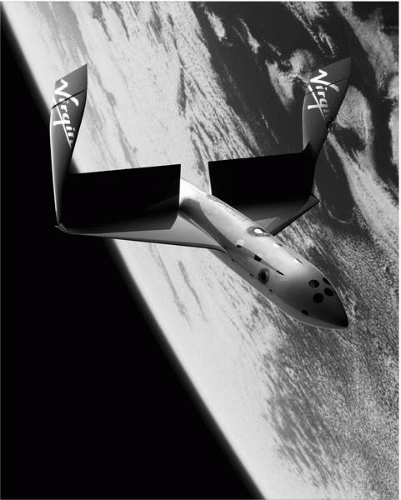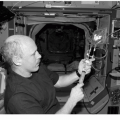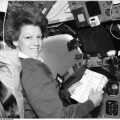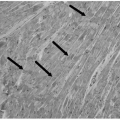Commercial Human Space Flight
Melchor J. Antuñano
James M. Vanderploeg
Richard T. Jennings
Elizabeth E. Richard
Vernon P. McDonald
I never think of the future. It comes soon enough.
—Albert Einstein
Although humankind has long dreamed of flying into space, we are only now on the verge of seeing these possibilities become a reality for more than a privileged few. Until recently, space flight has been limited to government-sponsored astronauts, cosmonauts, and taikonauts, and several citizens who could afford the multimillion dollar cost. However, we are now embarking on a new era in which many people will have the opportunity to travel into space. As noted in Chapter 29, the emergence of the commercial human space flight industry will significantly affect the field of aerospace medicine. In the future, aerospace practitioners will be confronted with health issues related to a wide variety of commercial space applications including orbital flights and suborbital flights with varying flight profiles and durations supporting activities such as space tourism; orbiting research and industrial laboratories; on-orbit assembly, repair, and provisioning facilities; and differing in-flight and ground support health and medical capabilities for each. This chapter will challenge the reader to consider how best to prepare for and address these new opportunities as a human space flight risk manager of the future.
THE COMMERCIAL HUMAN SPACE FLIGHT MARKET
Various forces will influence the ongoing development of the commercial human space flight industry. Although major technologic advances will not be required, improvements in design to make commercial spacecraft safe and reliable, an injection of institutional funding sources, and competition to drive prices down will all contribute to commercial feasibility. Additional drivers for development include the availability of orbital destinations such as space hotels and laboratories, a demand for new commercial space applications, and spaceports that can accommodate suborbital, orbital, and/or point-to-point transportation. Development of the orbital market will also benefit from the emergence of cost-effective launch capability spurred by government commitments, as well as a successful suborbital tourism market.
Although the numbers of space flight participants flying to the International Space Station (ISS) will remain very low, limited by the availability of launches and the multimillion dollar cost, the prospects of suborbital flights for $200,000 or less will open the doors to thousands of participants. Demand for space tourism appears promising. A 2006 Futron/Zogby survey projected 13,000 suborbital space flight participants per year by 2021, with projected annual revenue of more than $650 million in 2021 (1). Virgin Galactic, a leader in the emerging suborbital tourism market, had 100 passengers signed up who had already paid the full $200,000 fare by the end of 2006—well before the planned test flight program and maiden flight scheduled at least 2 years in the future. As of 2007, a total of 200 people from 30 countries had signed up to fly on Virgin Galactic’s suborbital flights (2). Branding and market presence have played a significant role in generating such early interest; companies in this competitive space race are investing in visual identity and promotion,some even choosing to design logos that reflect their futuristic ambitions and global appeal.
For suborbital space tourism to be successful, however, prices will need to come down. Key to this will be space vehicles that can fly repeatedly without requiring downtime for refurbishment and repair, and vehicles that have demonstrated safety and reliability records. Government may also spur development of the commercial industry by contracting commercial companies to deliver passengers and cargo to the ISS and other government space facilities. This will allow national space agencies to concentrate development on exploration initiatives to the moon and
Mars, thereby stimulating the growth of the low Earth orbit (LEO) commercial market for human space flight.
Mars, thereby stimulating the growth of the low Earth orbit (LEO) commercial market for human space flight.
EVOLUTION OF COMMERCIAL HUMAN SPACE FLIGHT
Although the definition of what truly constitutes a “commercial” space flight participant can be debated, space flights including noncareer crewmembers perhaps began with Charlie Walker. Confirmed by National Aeronautics and Space Administration (NASA) in 1983 as the first industrial payload specialist, Mr. Walker accompanied the McDonnell Douglas continuous flow electrophoresis (CFES) equipment as a crewmember on space shuttle missions STS-41-D, STS-51-D, and STS-61-B from 1984 to 1985. The Russian space program flew a number of crewmembers from other countries to its space stations, but the first commercial cosmonaut may have been Toyohiro Akiyama. The Tokyo Broadcasting System reportedly paid $28 million for his flight to the MIR in 1990, where he spent 1 week and provided daily television broadcasts. A consortium of British companies paid for British chemist Helen Sharman to fly to the MIR in 1991. The Russian space program, in conjunction with Space Adventures, then began to fly paying passengers to the ISS with the flight of Dennis Tito on April 28, 2001. At the time of this publication, an additional four space flight participants had been launched on Soyuz spacecraft and spent 10 days in orbit on the ISS including Mark Shuttleworth, Gregory Olsen, Anousheh Ansari, and Charles Simonyi.
While private space flight using privately developed space vehicles has been discussed for decades, perhaps the first step toward a real industry occurred when the Ansari X Prize competition ($10 million) was announced by Peter Diamandis in 1995 and subsequently awarded in 2004. The X Prize was similar to early 20th-century aviation prizes such as the $25,000 Orteig Prize won by Charles Lindbergh for his solo flight across the Atlantic Ocean. To win, a nongovernment organization had to launch a reusable human-piloted spacecraft into space, twice, within 2 weeks. The prize was won using the experimental spacecraft Space Ship One developed by Burt Rutan of Scaled Composites; the technology is owned by a Paul Allen company (Mojave Aerospace Ventures). The two flights were piloted by Mike Melvill and Brian Binnie.
At the time of this publication, the next X Prize competition, the $2 million Northrop Grumman Lunar Lander Challenge, will be competed in New Mexico in October 2007. While the original X Prize was privately funded, this one is sponsored by a major aerospace company and funded by NASA. Contestants will develop and prove concepts for space vehicles that could safely ferry humans or cargo back and forth between the lunar surface and lunar orbit.
In late 2004, Sir Richard Branson’s Virgin Galactic announced a collaboration with Burt Rutan to fly tourists into space using a scaled-up version of Space Ship One. Space flights for regular passengers are anticipated to begin in the 2009 to 2010 timeframe. Space Ship Two will be carried by White Knight II and climb to an altitude of approximately 100 km with a total flight duration of 2.5 hours (Figure 30-1). These suborbital flights will have a period of weightlessness of 4 to 5 minutes; the precise duration being driven by the altitude achieved. Initially launching from the Mojave Spaceport in CA, Virgin Galactic will ultimately be headquartered and launch out of Spaceport America in New Mexico.
Blue Origin, founded by Jeff Bezos of Amazon.com, seeks to lower the cost of suborbital space flight utilizing a different flight profile. Blue Origin is developing a vertical take-off and landing craft named New Shepard (3). This craft reached a height of 285 ft and successfully landed on November 13, 2006, and completed a second test flight in March 2007.
Other companies in the suborbital tourism market include Armadillo, BensonSpace, Myasishchev, PlanetSpace, Rocketplane/Kistler, Starchaser Industries, TGV Rockets, and X-Cor. A recent entry into this market worth noting came from European Aeronautic Defence and Space Company (EADS) Astrium. This announcement is significant because EADS is one of the largest aerospace companies in the world and reports indicate the cost of their program to be $1 billion. Several companies worldwide are also developing orbital space tourism capabilities, some facilitated by NASA Space Act Agreements (SAAs) as described in the subsequent text.
Orbital developers include BensonSpace, Energir Kliper, PlanetSpace, Rocketplane/Kistler, Shenzhou, Soyuz, SpaceX, Excalibur Almaz, and Transformational Space. Also, Space Adventures, who launched the first space tourists to the ISS on Soyuz spacecraft, announced plans in 2007 for additional orbital flights and circumlunar flights for a listed fee of $100 million, and hopes for a first tourist spacewalk from the ISS in 2009.
Other developers envision orbital destination tourism and other human-rated orbital commercial facilities such as Bigelow Aerospace (founded in 1999 by Budget Suites founder Robert Bigelow) using expandable modules such as Genesis I. This module was launched on July 12, 2006, from Russia and is a one-third scale mockup of a future module. Genesis I has a useable habitable volume of 11.5 m (3), and is currently in LEO.
In late June 2007, Bigelow Aerospace launched its second small-scale inflatable module aboard a Russian rocket. The module, Genesis 2, successfully joined Genesis 1 in orbit, and the company plans to launch a larger module in fall 2008. Bigelow is aiming to launch human-habitable modules into space for use as orbital accommodations by 2012. Future on-orbit applications may include pharmaceutical development, materials manufacturing, biotechnology research, industrial facilities, or materials manufacturing. On-orbit assembly, repair, and provisioning capabilities will likely be required for the development of orbiting hotels, industrial operations, research facilities, and other complex structures. In addition to the medical screening and training required for space flight participants engaging in tourism, these human-tended
facilities will require on-orbit health monitoring and occupational medicine services.
facilities will require on-orbit health monitoring and occupational medicine services.
Another type of commercial space transit, suborbital point-to-point transportation, may emerge in parallel with commercial orbital transport to deliver cargo or people from one place on Earth to another faster than ever before—with the potential to go halfway around the world in 40 minutes. Once the technology is available for suborbital flight, point-to-point travel will require the ground infrastructure to permit launch and landing in different locations.
Impact of Government Agency Programs
While suborbital tourism is being developed and funded by private sources, government agencies may provide funding that serves as a catalyst for commercial orbital space flight development. The 2005 NASA Authorization Act calls on NASA to advance space commerce. NASA announced a competition totaling $500 million for Commercial Orbital Transportation Services (COTS) to take cargo and possibly crew to the ISS, with a goal of acquiring reusable rockets that dramatically cut the cost of launching payloads into space. Two companies successfully competed for this initial funding, and NASA signed SAA on August 18, 2006 with Space Exploration Technologies (SpaceX) and Rocketplane-Kistler (RpK) to develop and demonstrate the vehicles, systems, and operations needed to support an orbital facility such as the ISS. NASA subsequently signed unfunded COTS SAAs with T-Space and PlanetSpace in February 2007.
In June 2007, NASA signed nonreimbursable SAAs with three additional companies: SpaceDev, SPACEHAB, and Constellation Services International (CSI). These companies will also work to develop and demonstrate the vehicles, systems, and operations needed to transport cargo to and from a LEO destination. The final option of the COTS program is for crew transport, and several of the companies plan to include this capability.
Infrastructure Requirements for Commercial Human Space Flight
While space flight operators focus on vehicle design and testing, commercial human space flight services are also emerging to address various aspects of human risk management and the provision of services and products to prepare space flight participants for flight. Tens of companies are offering new space launch services, and marketing access to Russian launchers. There are space tourism, zero-g simulation and training companies, infrastructure/subsystems engineering companies, commercial space exploration companies, and companies offering medical screening and health risk management services.
Critical to the infrastructure of each of these human space flight market segments will be the availability of spaceports to provide a convenient place from which to launch and land. Launch pads will be needed for orbital space vehicles, and the spaceports will have to be large enough and located such that human lives would not be endangered should an accident occur on the launch pad. Long runways to facilitate winged launch vehicles will be required for suborbital space vehicles and the hypersonic aircraft used for point-to-point suborbital transportation.
The New Mexico Space Authority is on schedule to open Spaceport America in Las Cruces, New Mexico, in 2008 with Virgin Galactic as the anchor tenant. Six commercial spaceports, located in Alaska, California (Vandenberg Air Force Base and Mojave Airport), Florida, Oklahoma, and Virginia, currently have Federal Aviation Administration (FAA) launch site operator licenses. Oklahoma received its launch site operator license in 2006. Several other commercial spaceports are under active development, including sites in New Mexico and Texas. Spaceports to support commercial human space flight are also under development or being considered worldwide in locations such as Australia, Canada, Russia, Singapore, Sweden, and the United Arab Emirates.
REGULATORY ENVIRONMENT: EVOLUTION OF SPACE FLIGHT GUIDELINES, STANDARDS, AND CERTIFICATION
Commercial Space Flight Regulation
The Office of Commercial Space Transportation (referred to as AST) in the FAA was created by the Commercial Space Launch Act of 1985; the AST is responsible for licensing private space vehicles and spaceports within the United States among other responsibilities. Congress also mandated regulations for commercial space flight through specific legislation entitled the Commercial Space Launch Amendments Act of 2004 (4). These regulations (Human Space Flight Requirements for Crew and Space Flight Participants) (5) were published by the FAA as a final rule in December 15, 2006 to protect the safety of the uninvolved public and enable passengers to make informed decisions about their personal safety. They do not impose health and medical standards for passengers or “space flight participants” but rather provide criteria for medical screening in the form of guidelines. There are a number of reasons for this approach including the regulatory restrictions placed on the FAA by the U.S. Congress, the state of the art in defining the medical risks of space flight for a population much broader than the historical space traveler, and the desire on the part of the commercial operators to not be restricted by a set of medical standards that might unnecessarily limit the breadth of their customer base. However, the rules do require operators to inform passengers about the general risks of space flight and the specific risks of space travel in the operator’s vehicle. Other aspects of the rules include medical qualifications of the crew and requirements for training.
Commercial companies are currently developing medical screening programs for crew and space flight participants and some have held workshops to develop medical screening guidelines (see subsequent text). The aerospace medicine professional could reasonably anticipate screening some of these crew and space flight participants over the next decade depending on the volume and scope of screening developed. FAA aviation medical examiners (AMEs) may require special training to conduct these space flight examinations for crews in the future.
Medical Screening of Crew and Space Flight Participants
The sections discussed earlier highlight a wide range of possibilities for human commercial space flight with the potential for thousands of people participating in suborbital and orbital flights. The participation of large numbers of private citizens raises many questions for the medical community in terms of how to accurately assess the risks posed to a particular space flight participant. The philosophy behind medical screening protocols for space flight participants is very different from government-sponsored astronauts, cosmonauts, or taikonauts. Whereas government-sponsored crewmembers must meet medical standards aimed at optimizing health and performance to carry out mission-specific tasks over an extended period of time, space flight participants are passengers with no required duties, and in the case of suborbital flights, very brief exposure to the space environment. While government agencies must fly a few well-trained individuals to carry out strictly defined objectives and potentially demanding tasks to achieve mission success, private operators want to fly as many people as safely as possible to achieve financial viability. These differences necessitate a very different approach to medical screening.
Stay updated, free articles. Join our Telegram channel

Full access? Get Clinical Tree








